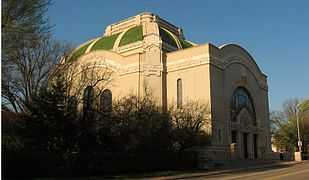Henry Hornbostel
Henry Hornbostel (1867–1961) was an American architect.
He designed more than 225 buildings, bridges, and monuments in the United States; currently 22 are listed on the National Register of Historic Places.
Born in Brooklyn, New York, he graduated in 1891 from Columbia University and also studied at the Ecole des Beaux Arts in Paris, France. He was a partner, over his career, in the New York firms of Howell, Stokes & Hornbostel; Wood, Palmer & Hornbostel; Palmer & Hornbostel; and Palmer, Hornbostel & Jones. He also practiced independently from a Pittsburgh, Pennsylvania office.
Buildings
Nearly half of his works (110) were in Pittsburgh, an industrial boomtown in the early twentieth century, where in 1904 he won the campus design competition for Andrew Carnegie's Carnegie Technical Schools (today's Carnegie Mellon University). He also helped to establish Carnegie Mellon School of Architecture that same year. He also designed many of the original buildings of Emory University in Atlanta.
-

Rodef Shalom Temple from Fifth Avenue, Pittsburgh, Pennsylvania
-

Soldiers and Sailors National Military Museum and Memorial in Pittsburgh
-

Chapter House of St. Anthony Hall, Columbia University, New York City
-

Pittsburgh City-County Building, Henry Hornbostel, designer; Edward B. Lee, architect, with Palmer, Hornbostel & Jones
-

Hamerschlag Hall at Carnegie Mellon University, Pittsburgh
-

Williamsburg Bridge, New York City
-
Carnegie Mellon College of Fine Arts, Pittsburgh
-
.jpg)
Congregation B'nai Israel (Urban League of Pittsburgh Charter School), Henry Hornbostel, with William S. Fraser, Philip Friedman, and Alexander Sharove
-

Schenley Apartments. Henry Hornbostel, with Rutan & Russell
-

Carnegie Mellon University, the original campus (Carnegie Institute of Technology; Carnegie Technical Schools), Palmer & Hornbostel, Henry Hornbostel
-
Church.jpg)
Smithfield Congregational (United) Church (currently Smithfield United Church of Christ), located at 620 Smithfield Street in Downtown Pittsburgh
Among his many landmarks are:
- Rodef Shalom Temple, Pittsburgh (1904)
- Soldiers and Sailors National Military Museum and Memorial, Pittsburgh (1907)
- Pittsburgh City-County Building, (1915–1917, with Edward B. Lee)
- At his Alma Mater, St. Anthony Hall Fraternity, New York (Building #96000484 listed as "Delta Psi, Alpha Chapter" .
Hornbostel is also noted for his work on the Queensboro Bridge (1909), and the Hell Gate Bridge (1916) done jointly with Gustav Lindenthal.
References
- Kidney, Walter C. (2002). Henry Hornbostel: An Architect's Master Touch. Pittsburgh: Pittsburgh History and Landmarks Foundation & Roberts Rinehart Publishers. ISBN 1-57098-398-4.
- Patricia Lowry (2002). New book assesses Henry Hornbostel's influence on Pittsburgh: Pittsburgh Post-Gazette. Retrieved April 26, 2006.
External links
|



